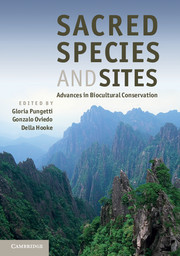Book contents
- Frontmatter
- Contents
- List of Contributors
- Foreword
- Preface
- Acknowledgements
- Introduction
- Part I Concepts and Knowledge
- Part II Sacred Landscapes
- 5 Ecological and spiritual values of landscape: a reciprocal heritage and custody
- 6 Sacred mountains and national parks: spiritual and cultural values as a foundation for environmental conservation
- 7 The history of English churchyard landscapes illustrated by Rivenhall, Essex
- 8 Exmoor dreaming
- Part III Sacred Sites and People
- Part IV Sacred Species
- Part V Sacred Animals
- Part VI Sacred Groves and Plants
- Part VII Implementation and Conclusions
- Index
- Plate Section
- References
7 - The history of English churchyard landscapes illustrated by Rivenhall, Essex
from Part II - Sacred Landscapes
Published online by Cambridge University Press: 05 August 2012
- Frontmatter
- Contents
- List of Contributors
- Foreword
- Preface
- Acknowledgements
- Introduction
- Part I Concepts and Knowledge
- Part II Sacred Landscapes
- 5 Ecological and spiritual values of landscape: a reciprocal heritage and custody
- 6 Sacred mountains and national parks: spiritual and cultural values as a foundation for environmental conservation
- 7 The history of English churchyard landscapes illustrated by Rivenhall, Essex
- 8 Exmoor dreaming
- Part III Sacred Sites and People
- Part IV Sacred Species
- Part V Sacred Animals
- Part VI Sacred Groves and Plants
- Part VII Implementation and Conclusions
- Index
- Plate Section
- References
Summary
Introduction
Christianity finally became the dominant religion in England after the conversion of the Anglo-Saxons. Among its sacred sites are the local churches and their curtilages, the churchyards. Most churchyards are doubly sacred on account of the burials and of the cultic building. Over the past 30 years there has been a growing recognition of their biodiversity value. These two statements are not unlinked.
This chapter explores how these sacred sites were selected in the first place and later extended. It examines how they were treated and the effect of this on biodiversity, especially plants. It concludes with a review of modern approaches to churchyard care.
Churchyards were and still are consecrated (Taylor, 1983). Church of England churchyards, along with the church buildings, thereby fall under Faculty Jurisdiction and receive ‘ecclesiastical exemption’ from Listed Building Consent under secular planning control. So for many purposes, although not all, planning control is maintained through Diocesan Advisory Committees (DACs) for the Care of Churches and the diocesan Consistory Courts. This means that they are sacred sites managed in a distinctly different way to other land holdings. This chapter is written from the perspective of 16 years’ experience on DACs and from the perspective of 17 years as rector (parish priest) of Rivenhall.
- Type
- Chapter
- Information
- Sacred Species and SitesAdvances in Biocultural Conservation, pp. 97 - 110Publisher: Cambridge University PressPrint publication year: 2012
References
- 1
- Cited by



